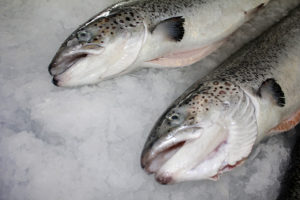The Forgotten Pillar: Four Facts About Seafood’s Food-Safety Record
When asked about seafood sustainability, what comes to mind? Environmental responsibility? Social responsibility? Animal welfare? While all three are pillars of seafood sustainability, there’s a fourth pillar that, unfortunately, is often left out of the equation — food safety.
Food safety refers to the handling, preparing and storing of food in a way that reduces the risk of people getting sick from foodborne illnesses such as Salmonella, norovirus, campylobacter, E. coli, Listeria and Clostridium perfringens. Like all proteins, fruits and vegetables, seafood is susceptible if handled, prepared or stored improperly.
For the aquaculture facilities that are part of the global seafood supply chain — farms, hatcheries, feed mills and processing plants — food safety is as critical as environmental responsibility, social responsibility and animal welfare. Think about it. How sustainable is your operation if the people who are eating the food that you produce are getting sick?

Here are four facts about seafood’s food-safety record, especially as they pertain to aquaculture, with a focus on the United States.
It’s all about control.
All facilities that produce seafood sold in the United States, whether domestic or foreign, are required to adhere to HACCP (Hazard Analysis and Critical Control Point). Mandated by the U.S. Food and Drug Administration in 1997, HACCP is a management system in which food safety is addressed through the analysis and control of biological, chemical and physical hazards from raw material production all the way through the consumption of the finished product. HACCP has worked so well for seafood that it was the model for the FDA’s Food Safety Modernization Act, signed into law in 2011, as well as for other national food-safety laws since its inception 20-plus year ago.
The advantage of aquaculture.
Farmed seafood has an advantage over wild seafood, as it offers more control points prior to harvest. Farmed finfish and shellfish are born in a hatchery that adheres to strict controls, reared in a farm that adheres to strict controls, and fed feed manufactured in a feed mill that adheres to strict controls.
Seafood-attributed outbreaks are on the decline.
In the United States, the number of foodborne disease outbreaks attributed to seafood is falling. According to the U.S. Center for Disease Control and Prevention, there were 801 seafood-attributed outbreaks from 1998 to 2006 compared to just 435 seafood-attributed outbreaks from 2007 to 2015. That’s an annual average of 89 between 1998 and 2006 compared to just over 48 between 2007 and 2015. Has the emergence of aquaculture over the past 20 years contributed to a safer global seafood supply? Perhaps. In 1998, aquaculture represented only one-third of global human seafood consumption. Today, it represents half.
Look for Best Aquaculture Practices.
In addition to national food-safety laws like HACCP, many aquaculture facilities are third-party certified. These certification programs often go above and beyond what governments require to ensure that facilities are operating in a responsible manner and employing best practices. Food safety is a pillar of the Global Aquaculture’s Best Aquaculture Practices certification program, along with environmental responsibility, social responsibility and animal welfare. Look for the blue BAP label when purchasing seafood!




